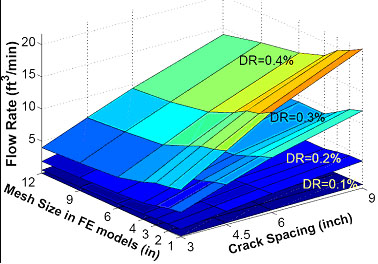Professor Hutchinson Receives Two Grants for Concrete Damage-Flow and Building Foundation Rehabilitation
NSF grants awarded for civil and environmental engineering research projects
August 29, 2005 -- Tara Hutchinson, Ph.D., assistant professor in civil and environmental engineering, has received a two-year $300,000 grant from the National Science Foundation (NSF) that will help in her research for the development of concrete damage-flow rate correlation, as well as a one-year $70,000 NSF grant that will support her research in building foundation rehabilitation.
Collaborating with Falko Kuester, Ph.D., assistant professor in electrical engineering and computer science, the team will utilize the $300,000 grant to develop an X-ray tomography system to be used in conjunction with structural testing fixtures for studying concrete damage propagation and its correlation with permeability and flow rate.
“Concrete is one of our most widely used materials, especially in building construction, however, ironically it is one of the most poorly understood composite materials due to its highly heterogeneous nature” Hutchinson said. “In this work, we will evaluate the fluid flow through concrete, especially through concrete that has been damaged by seismic loads.”
Once correlations between permeability and flow, and damage, in concrete are developed it will be feasible to measure and assess the health of buildings that are already constructed by utilizing porosity testing components, such as walls, applying nondestructive testing methods.
Studying shear walls, or the walls specifically designed to resist horizontal loads by adding stiffness applied in the plane of the wall, is one of their main research focuses, and they will conduct numerous tests with different samples and loading configurations.
Hutchinson said their X-ray tomography system will send X-rays through the wall to analyze the composition and especially define internal voids, which can be correlated with air permeability or flow rate.
Their concrete research will eventually help lead to the reduction of cost in new infrastructure and provide the resources to rehabilitate and assess the health of existing structures. She also said their findings will improve the service life of one of the most abundantly utilized construction materials.
Hutchinson’s additional one-year NSF grant totaling $70,000 will help support her building foundation rehabilitation research.
“This is a big problem in Europe, and is becoming a challenge in densely populated, older urban cities in the United States. When a building requires rehabilitation, say for additional occupancy needs, and is surrounded by many other buildings, especially of historical significance, it is difficult to retrofit the structure of interest to support new loading requirements without damaging its surrounding foundations,” she explained.
Hutchinson, along with colleague, Dan Wilson, Ph.D., from UC Davis, and colleague Debra Laefer, Ph.D., from Ireland, are researching how to re-use and protect these foundations by utilizing helical piers combined with grout. This results in a helical pier, or a long, thin rod that acts like a screwdriver, with an additional cemented area surrounding it, adding strength to the existing foundation.
The solution will require simply drilling holes large enough for the piers - about three to four inches in diameter - through existing pile foundations into soils below, and then placing low strength, highly fluid grout at elevations well below the existing building pad. The team will conduct this research at both UC Irvine and at the geotechnical centrifuge located at UC Davis.
“We’re just combining two technologies to create a simple solution for a growing problem facing older building sites,” she added.

Example design curve (generated from finite element simulations) correlating design drift ratio (DR), flow rate through wall, and (assumed) crack spacing (Wang and Hutchinson).
